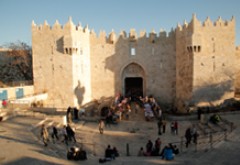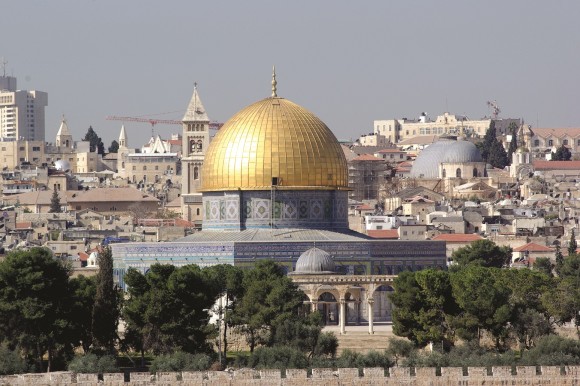Location
The Dome of the Rock is located in the middle of al-Aqsa Mosque compound, centered in an open space that rises from the ground level of al- Jami’ al-Aqsa by around four meters. This space is currently known to the people of Jerusalem as the Rock Level. It is nearly square in shape and is accessed by eight colonnades.
Nature of the Dome of the Rock
The Rock is made up of natural, irregularly shaped stone measuring 18 x 13 meters and 1.5 meters high. It is surrounded by a decorated, wooden fence that dates back to the Ayyubid era. Below the Rock, there is a square shaped cave (4.5m) that has one hollow mihrab (niche) and another flat one. Many Muslims pray inside this cave, because they believe that their prayers are answered in following the footsteps of Prophet Muhammad, who lead a prayer there with most of the revered prophets.
Importance and Stature of the Dome of the Rock Building
The Dome of the Rock is the icon of Jerusalem and Palestine and is a destination for students, believers, tourists, scientists, and artists. Historically, it is the oldest Islamic architectural site still standing to this day. Religiously, it is the site of the miracle of the Isra and Mi’raj, one of the most spiritual and magnificent manifestations in Islam. Artistically, it is a landmark of the beginning of Islamic art, encompassing mosaic formations of nearly 1,000 square meters and considered one of the most fascinating mosaic designs, in very good condition and concentrated colors. Architecturally, it is a unique artifact, the like of which was never built in Islamic architecture, in terms of design or usage. What is seen today is the Dome of the Rock as it was constructed by Abdul Malek Ibn Marwan without any major changes or alterations, especially in terms of the scheme, the area, and most of the decorations. This preservation is very rare in Islamic architecture. Usually, mosques and token buildings are built on and amended, making it difficult to trace their early stages or origins. This is one of the most beautiful man-made structures, admired by all visitors, regardless of their affiliations or religions.
Founder and Curators
Historical resources agree that Umayyad Caliph Ibn‘Abed al-Malik ibn Marwan (685-705AD/ 65-86 H) was the one who ordered the construction of the Dome of the Rock, which started in 688-689 AD (69 H) and was completed in 691 - 692 AD (72 H). The construction took four years to complete, during which ‘Abed al-Malik used Egypt’s revenue for seven years. He appointed Raja’ ibn Haywah, a prominent man in Palestine and one of the advisors in the Umayyad era, and Yazid Ibnibn Salam to undertake all that was necessary to complete the construction.
Exterior of the Dome of the Rock
The Dome of the Rock is set up on a circular arcade, in which 16 windows were opened and adorned with stocco decorations covered in colored glass. The decorations display a variety of plant and geometrical designs and inscriptions. The drum is covered by tiles decorated with text from the Quranic sura (verse), al-Isra. The dome is spherical in shape and covered with gold plated copper panels, it culminates with a golden crescent.
The four cardinal sides have doors leading inside the structure, while each of the eight sides extends around 20.6 meters and is 9.5 meters high. The lower part is covered with decorated marble; the upper part is adorned with decorative tiles of multi colors and geometrical and plant motifs. In the upper part of each of the eight sides are seven windows, five of which are open and two, on each side, are closed. The doors were designed in a way as to give anyone entering the shrine from any of the doors a full view of the columns and pillars without any obstruction. This was accomplished by slightly slanting the circle of the structure’s pillars, which measures 2.5 degrees according to the scientist Richmond and 3 degrees according to Creswell. Without this slant, the pillars on the opposite side of the point of entrance would have been blocked by those nearest, because they would be in a straight line.
Plan of the Dome of the Rock
The scheme of the Dome of the Rock is composed of two octagonal structures, one interior and the other exterior, surrounding the domed structure that encompasses the Rock. The exterior octagonal structure is based on eight piers and on 16 columns, with two columns between every two pillars. The interior octagonal structure is confined between the exterior octagonal structure and the piers and pillars that support the drum of the dome. There are four pillars and 12 columns here, supporting semi circular arches, the arches are connected togather by decorated wooden beams.. The façades and extrados of the archs are decorated with mosaics and golden Kufi script on a colored background.
From the inside, the dome sits on a circular drumsupported by semi-circular arches carried on four pillars and 12 columns. The drum is divided into two parts. The lower part displays mosaics with flower and geometric motifs, as well as inscriptions in green and gold . Most of these decorations date back to the Umayyad era and are similar to those found in the Umayyad Mosque in Damascus. The decorations have attracted a variety of scientists and specialists in an attempt to explain them and decipher their symbolism. Motifs of vases, crowns, plant elements, palm leaves, pine cones, grape leaves, and other elements make up most of these mosaic decorations.
Dome of the Rock in the Times of the Franks (Crusaders)
The Franks turned the Dome of the Rock into a church, calling it Templum Domini and adding icons, crosses, and an iron fence that surrounded the Rock and is now preserved in the Islamic Museum. The construction of this fence was mentioned by Ibn al-Athir, saying that the pilgrims were paying gold and silver to get a piece of the Rock, which led the authorities at that time to build the iron fence in order to protect it.








